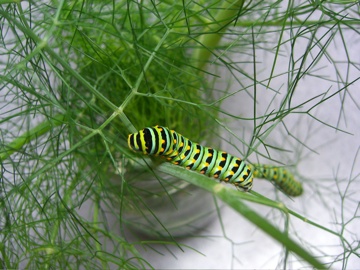Earlier this month, Kate spotted some wild fennel stuffed into a yard-waste bin here in the neighborhood. Wild fennel, which has become profuse here, is kind of weedy and annoying; once it takes root, it’s very hard to get rid of.
But it’s also a host plant for a butterfly called the anise swallowtail (Papilio zelicaon), whose image has graced this blog before. It’s a largish black-and-yellow beauty, at least in the eye of this beholder.
So, having spotted the fennel in the bin, Kate took a look to see if any anise swallowtail caterpillars might be there, too. To her surprise, she found 10, including a couple that were probably close to going into their chrysalides. So she brought the caterpillar and their host sprigs of fennel back home, where they took up residence in our dining room.
Within just a few days, one of the caterpillars crawled onto the vase that held the fennel and began preparing to go into its chrysalis. We left town for a couple of days, and when we came back, the chrysalis was complete. (See the photos below; click for bigger versions of the images.) That was less than two weeks ago. Since we’ve sometimes watched chrysalides for months and months before a butterfly appears (if one appears at all), I was kind of thinking we’d be into the autumn before anything more happened.
But this morning, Kate got up, walked into the dining room, then called out, “We have a butterfly out here now!”
So now, it’s doing what it needs to do for the next stage in its life cycle. We’ll watch.


